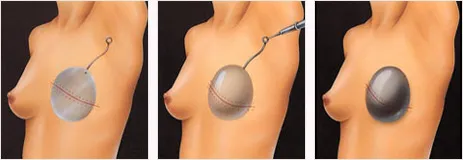Tissue Expansion in Birmingham AL
Skin Growth for Reconstructive Plastic Surgery
Tissue Expansion is a procedure that enables the body to "grow" extra skin for use in reconstructing almost any part of the body. A silicone balloon expander is inserted under the skin near the area to be repaired and then gradually filled with saline or carbon dioxide over time, causing the skin to stretch and grow.
Tissue expansion is most commonly used for breast reconstruction following breast removal, but it's also used to repair skin damaged by birth defects, accidents, surgery and in certain cosmetic procedures.
Tissue Expansion Candidates
Almost anyone in need of additional skin can benefit from tissue expansion, from infants to elderly men and women. The procedure is used widely in breast reconstruction when there is not enough skin to accommodate a permanent implant to restore a woman's natural appearance. Tissue expansion is also an option for repairing or replacing areas of the scalp where hair growth makes it difficult to replace lost tissue with skin from other areas of the body.
Tissue expansion generally produces excellent results when reconstructing some areas of the face and neck, hands, arms and legs. Expansion may be more difficult on the back, torso or other areas where skin is thick. If the affected area is severely damaged or scarred, expansion is probably not an option since healthy skin is the first requirement.
Tissue Expansion Advantages
Until recently, surgeons were limited to skin flaps and skin grafts to reconstruct damaged tissue. Tissue expansion provides an added technique with several advantages:
- Near-perfect match of skin color, texture and hair-bearing qualities.
- Smaller risk that the skin will die because it remains connected to the donor area's blood and nerve supply.
- Less apparent scars because the skin doesn't have to be moved from one area to another.
Tissue Expansion Disadvantages
Depending on the area to be reconstructed, tissue expansion can take as long as 3 to 4 months to grow additional skin. During this time, the expander creates what can be an unsightly bulge, which is desirable in breast reconstruction but can be quite noticeable for someone requiring repair of the scalp or other areas of the body. The procedure also requires repeated visits to the surgeon for injection of the saline that inflates the balloon. For some people, the inconvenience and obvious appearance of an expander are enough for them to consider other options.
Your Tissue Expansion Consultation
During your initial consultation, your surgeon will evaluate your condition. Your age, skin condition, medical history and other factors will help your surgeon determine if you'll benefit from tissue expansion.
Your flexibility and tolerance for the inconvenience associated with this procedure will help you determine if you want to pursue it. Before proceeding with tissue expansion, discuss your expectations and your understanding of it with your surgeon.
Tissue Expansion Risks and Safety
Skin expansion at Hedd4en & Gunn Plastic Surgery can produce some remarkable results. However, as with any operation there are risks associated with surgery and specific complications associated with this procedure.
The most common concern is that the silicone expander used in the procedure will break or leak while it is in the body. While expanders are rigorously tested and placed with care, leaks do occur. If the expander should leak, the saline solution used to fill the expander is harmlessly absorbed by your system and the expander is replaced in a relatively minor surgical procedure.
A small percentage of patients develop an infection around the expander. While this may occur at any time, it's most often seen within a few weeks after the expander is inserted. In some cases, the expander may need to be removed for several months until the infection clears. A new expander can then be inserted.
Preparing for Tissue Expansion
Your plastic surgeon will give you specific instructions on how to prepare for surgery, including guidelines on eating and drinking, smoking and taking or avoiding certain medications.
If you smoke, your surgeon will probably ask you to quit for at least 2 weeks before and after your surgery, since smoking may have an effect on how well you heal.
You should arrange for someone to drive you home after your surgery and to help you afterwards if needed.
Tissue Expansion Procedure
Your surgeon may use local anesthesia combined with a sedative to make you drowsy. You will be awake but relaxed, and should feel little discomfort. Your surgeon may instead recommend the use of a general anesthesia, where you will sleep through the entire operation.

In most cases, the initial operation will take 1 to 2 hours depending on the size and area of skin to be expanded. Your surgeon will insert the silicone balloon expander into a pocket created beneath the skin. The expander includes a self-sealing valve or gas cylinder that allows the surgeon to gradually fill the expander with saline or carbon dioxide.
Once the incision has healed, you'll be asked to return to your surgeon's office periodically so that the expander can be filled. Your skin will stretch as the expander enlarges. The expander is filled by inserting a needle into the self-sealing valve, which may be under the skin, or by using a remote dosage controller to fill the expander with carbon dioxide.
When the skin has stretched enough to cover the affected area, you'll have a second operation to remove the expander and reposition the new tissue. In breast reconstruction, the surgery required to remove the expander and insert the permanent implant is relatively brief. More complex surgery to repair skin on the face or scalp will take longer and may require more than one expansion sequence to complete.
Scalp Repair
Tissue expansion is ideal for scalp repair because the stretched skin on the scalp retains normal hair growth. Most other body tissue does not grow hair to the same degree.

Breast Reconstruction
A silicone balloon expander is inserted beneath the skin. Once in place, the expander is gradually filled over time. When the tissue has grown to the desired amount, the expander is removed. In breast reconstruction, a permanent implant is then inserted.

Tissue Expansion Recovery
How you feel after surgery depends on the extent and complexity of the procedure. The initial surgery to insert the expander causes most patients only temporary discomfort which can be controlled with medication prescribed by your physician.
You may feel some minor discomfort each time saline is injected into the expander, but this usually lasts only an hour or two. The follow-up procedure to remove the expander and put the new tissue in place may create some temporary discomfort, but this too can be controlled with medication.
Most tissue expansion patients find they can keep up with their normal routine while the expander is in place. Following the second surgery, most patients are up and about within a week.
Tissue Expansion Results
The results of tissue expansion are generally superior to other methods used to reconstruct or repair damaged skin. For most tissue expansion patients, the procedure dramatically improves their appearance and quality of life following surgery. If you're physically healthy, psychologically stable and realistic in your expectations, you'll probably be quite pleased with your new look.
Procedure Information © American Society of Plastic Surgeons

Tissue Expansion generates extra skin on virtually any area of the body for reconstructive plastic surgery procedures.
Birmingham, AL Office & Surgery Suites
Hedden & Gunn Plastic Surgery140 Village Street
Birmingham, AL 35242
205-980-1744 or 800-HeddenMD
 *
*  *
* 
Contact Us Today
Questions About Body Contouring?
Contact Hedden & Gunn Plastic Surgery in Birmingham, AL today to learn more about Tissue Expansion and other reconstructive plastic surgery techniques.
To schedule your consultation at the earliest possible date, please call 205-980-1744.
required fields are marked with an asterisk *
